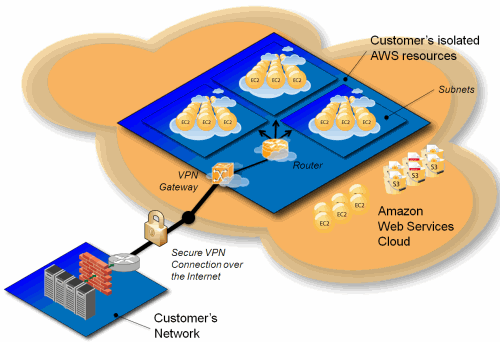A VPC is a private cloud running on public infrastructure
Cloud computing resources are dynamically allocated to customers as they’re needed, working on the same physical hardware. This concept of multi-tenancy is essential to public cloud infrastructure. As more businesses turn to hybrid cloud solutions, Virtual Private Clouds (VPCs) have emerged as popular enterprise security software solution. Using VPCs, businesses can secure corporate communications while leveraging scalable, economical public cloud infrastructure.
According to IBM, “a VPC is hosted on multi-tenant architecture, but each customer’s data and workloads are logically separate from those of all other tenants. The cloud provider is responsible for ensuring this logical isolation.”
Key features of VPCs include, principally, security against prying eyes from the outside. They are logically isolated from public cloud traffic, keeping information within corporate control without crossing the Internet. VPCs can provide organizations with redundancy and fault-tolerance. VPCs, implemented as cloud-based managed software solutions, provide a lower capital outlay for businesses which no longer need to buy specialized hardware and train staff to support it.

VPCs represented a global $36.29 billion market opportunity opportunity in 2021, according to a Research & Markets report. The report estimates a compound annual growth rate (CAGR) of 13% through 2027, reaching $77.66 billion. VPCs are expected to continue to grow in use as businesses adapt to hybrid work accommodations for employees, who increasingly expect to be able to work form anywhere, on any device.
“A VPC is ideal for companies seeking high levels of security, privacy and control, such as healthcare and financial organizations dealing with regulatory compliance. Businesses also find VPC ideal for running mission-critical applications,” said Rackspace.
A VPC is different than a private cloud. While VPCs secure private data on public infrastructure, private clouds do not. Private clouds encapsulate all services and infrastructure separately from public cloud infrastructure. VPCs run on shared public infrastructure, using layers of traffic isolation and security to provide a secure private environment. Ultimately, data within the VPC is isolated from public cloud data.
“A virtual private cloud is actually a public cloud offering. A private cloud is a single-tenant cloud environment owned, operated, and managed by the enterprise, and hosted most commonly on-premises or in a dedicated space or facility,” said IBM.
Private data, but public cloud infrastructure
Traffic in the VPC is logically isolated from other virtual networks hosted on the common cloud infrastructure. VPCs comprise several key technologies to isolate their traffic from the public cloud. They include subnets, Virtual Local Area Networks (VLANs) and Virtual Private Networks (VPNs).

Subnets are ranges of TCP/IP addresses reserved exclusively for private use — ones that are not visible or accessible on the public internet. VLANs partition the private cloud’s network traffic, and VPNs use encryption to keep network traffic private en route via public pathways.
“A VPC will have a dedicated subnet and VLAN that are only accessible by the VPC customer. This prevents anyone else within the public cloud from accessing computing resources within the VPC,” said Cloudflare.
“VPC customers can run code, store data, host websites, and do anything else they could do in an ordinary private cloud, but the private cloud is hosted remotely by a public cloud provider.”

